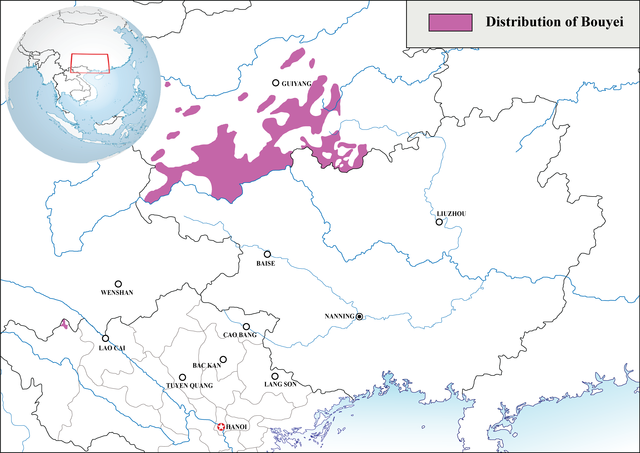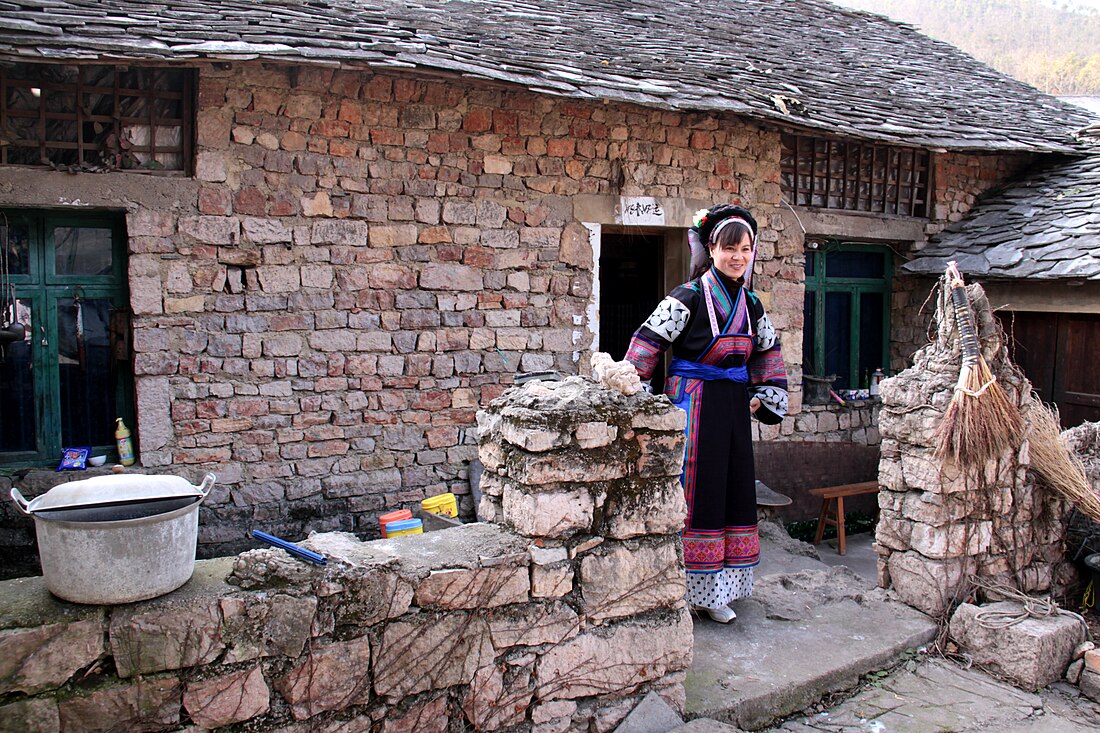Top Qs
Timeline
Chat
Perspective
Bouyei people
Asian ethnic group From Wikipedia, the free encyclopedia
Remove ads
The Bouyei (also spelled Puyi, Buyei and Buyi; Bouyei: Buxqyaix, [puʔjai] or "Puzhong", "Burao", "Puman"; Chinese: 布依族; pinyin: Bùyīzú; Vietnamese: người Bố Y) are an ethnic group living in Southern Mainland China. Numbering 3.5 million, they are the 10th largest of the 56 ethnic groups officially recognized by the People's Republic of China.


The Bouyei primarily live in the Qianxinan and Qiannan prefectures of southern Guizhou Province, as well as in Yunnan and Sichuan provinces and the Guangxi Zhuang Autonomous Region.[4]
Some 3,000 Bouyei also live in Northern Vietnam, where they are one of that nation's 54 officially recognized ethnic groups. In Vietnam, they are located in Mường Khương District of Lào Cai and Quản Bạ District of Hà Giang Province.
Remove ads
Names
The Bouyei consist of various subgroups. Below are their autonyms written in the International Phonetic Alphabet with numerical Chao tones.[5]
- pu˦˨ ʔjɐi˦˨, 濮越
- pu˦˨ ʔji˨, 濮夷
- pu˦˨ noŋ˧˩, 布侬
- pu˦˨ loŋ˧˩, 补笼
- pu˦˨ na˧˩, 布那
- pu˦˨ tu˦˨, 布土、布都
- pu˦˨ ʔjaŋ˧, 布央
- pu˦˨ zoŋ˧˩xa˧˥, 布笼哈
Some clans within the Bouyei groups include:
- pu˦˨ wu˦˨, 布武
- pu˦˨ wei˧˩, 布韦
- pu˦˨ lo˨˦, 布鲁
In Congjiang County, Guizhou, there is a group that refer to themselves as "Buyeyi, 布也益", but are officially classified by the Chinese government as ethnic Zhuang.[6]
Remove ads
Distribution
Summarize
Perspective
In China by county
(Only includes counties or county-equivalents containing >0.1% of China's Bouyei population.)
In Vietnam
In Vietnam, the Bố Y are recognized as one in 54 official ethnic groups. They mainly live in two localities: Mường Khương district of Lào Cai province (Tu Dí subgroup) and Quản Bạ district of Hà Giang province.[citation needed]
Remove ads
Language
The Bouyei speak the Bouyei language, which is very close to Standard Zhuang. There is a dialect continuum between these two. The Bouyei language has its own written form, created by linguists in the 1950s based on the Latin alphabet and with spelling conventions similar to the Pinyin system that had been devised to romanise Mandarin Chinese.
History
Summarize
Perspective
The Bouyei are the native Tai peoples of the plains of Guizhou. They are one of the oldest peoples of China, living in the area for more than 2,000 years. During the Spring and Autumn Period (770–476 BCE), the ancestors of Bouyei lived in Zangke (modern Guizhou), connecting with the state of Qi. The area, part of Jingzhou’s southwest, was called “Nanman” and included states like Zangke, centered in Yelang City (modern Anshun). Prior to the establishment of the Tang dynasty, the Bouyei and Zhuang were linked together; the differences between both ethnic groups grew greater and from year 900 already they were two different groups. The Tang set up feudal systems in Bouyei areas, but uprisings occurred in 812 CE. In the Song Dynasty in 1044 CE, Bouyei from Libo joined a rebellion in Guangxi. The Yuan dynasty introduced the tusi (chieftain) system, and in 1301 CE, Bouyei and others rebelled against Yuan rule. The Ming dynasty established Guizhou as a province in 1413, but faced Bouyei-led rebellions. The Qing dynasty abolished the system of local heads and commanded in its place to officials of the army which caused a change in the local economy; from then on, the land was in the hands of a few landowners, which caused the population to revolt.[7] During the Nanlong Rebellion (南笼起义) of 1797 led by Wang Nangxian, the Bouyei underwent a strong repression that caused many of them to emigrate to Vietnam.
The 1911 Xinhai Revolution ended Qing rule, and from 1912 to 1921, Yunnan warlords controlled Guizhou. Communist influence grew in Bouyei areas in Guizhou in the 1930s, with the Chinese Red Army liberating parts of Libo in 1930 and establishing a revolutionary base there by 1933. The Red Army passed through Bouyei areas during the 1935 Long March. After the founding of the People’s Republic of China in 1949, Bouyei autonomous regions Qianxinan and Qiannan were established in 1982 and 1956 respectively.[7]
Remove ads
Culture
Summarize
Perspective
Many Bouyei are agricultural farmers who commonly cultivate crops for consumption or sale like rice, millet, wheat, potatoes, maize, cocoa, tea, silk and many other types of crops. The Bouyei have also played a major role as intermediate merchants in the region. Due to changing economies, the Bouyei engage in both small-scale and large-scale commercial or business operations.[8]
Traditional Bouyei handicrafts and batiks are renowned throughout the region. The Bouyei celebrate many festivals, both native and those derived from Han culture. One native festival is called the Ox King's Day(牛王节) on April 8, an annual celebration meant to honor oxen and their contribution to agricultural activities.[9] June 6 is an important traditional Buyei holiday for ancestral worship. The story behind this tradition exists. According to Bouyei mythology, after Pangu became an expert in rice farming after creating the world, he married the daughter of the Dragon King, and their union gave rise to the Buyei people.
The daughter of the Dragon King and Pangu had a son named Xinheng (新横). When Xinheng disrespected his mother, she returned to heaven and never came down, despite the repeated pleas of her husband and son. Pangu was forced to remarry and eventually died on the sixth day of the sixth month of the lunar calendar.
Xinheng's stepmother treated him badly and almost killed him. When Xinheng threatened to destroy her rice harvest, she realized her mistake. She made peace with him and they went on to pay their respects to Pangu annually on the sixth day of the sixth month of the lunar calendar.
There are Christian churches among the Bouyei ethnic group in China. Most of them are in Guizhou and Yunnan. There is Catholic influence.[10][11][12] Catholicism entered Guizhou in 1714, with missionaries spreading the faith among Bouyei communities and creating a Latin-based Bouyei language script by 1797 and 1800 to aid religious education. The introduction of Catholicism also led to anti-Catholic sentiment among the Bouyei community. In 1879, the Roman Catholic Diocese of Nanlong was established in Nanlong (now Anlong County).[7]
Remove ads
Notable Bouyei people
- Cen Nanqin (岑南琴), slalom canoeist[13]
- Guo Jian (郭健), artist
- Huang Xiaoyun (黃霄雲), singer and actress
- Wang Nangxian, leader of the anti-Manchu White Lotus Rebellion
- Xiao Sha (肖莎), gymnast
- Cheng Lianzhen (郑幺妹), bandit leader and politician
- Meng Sufen (蒙素芬), politician
- Lu Ruiguang (陆瑞光), revolutionary
See also
References
External links
Wikiwand - on
Seamless Wikipedia browsing. On steroids.
Remove ads

